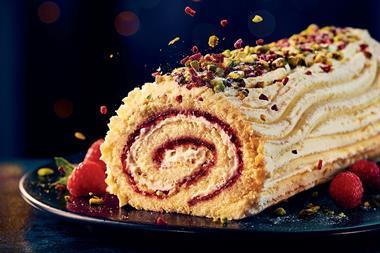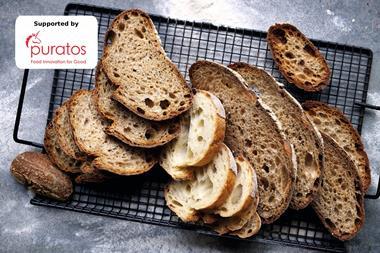While the constant stream of gluten-free NPD seems to continue unchecked, there are still areas of the market to explore, argue ingredients suppliers.
Consumers’ appetite for gluten-free goods shows no sign of abating – and neither does the willingness of bakers to meet that hunger.
Last month, for example, brought the launch of Pret A Manger’s first gluten-free bread, a recipe created by the brand’s own chefs, that contains teff, buckwheat and quinoa flours with millet, red quinoa, sourdough and a dash of treacle.
Other recent launches have included new gluten-free mixes from Dawn, Eurostar Commodities’ first gluten-free flour and a gluten-free rustic sandwich baguette from Aryzta. However, despite the constant flow of NPD from across the industry, there remain untapped opportunities in the gluten-free bakery market.
Speaking to British Baker recently, Edme suggested bakers reproducing European-style bread with gluten-free flours would find they were “knocking at an open door with consumers”. Also, widening consumer interest in sourdough means this is an area to consider, with businesses including Gail’s already offering such products.
Doughnuts, Danish pastries and scones are also areas to tap, suggests Dr Jonquil Dawson, UK & Ireland formulator at Lesaffre. “Technically, these are some of the more challenging areas as the products rely on structure, quality and exceptional taste to create sales,” she says.
Gavin Mulligan, NPD manager at Edme, suggests gluten-containing bakery products have the potential to be gluten-free and expand the market. “Often, this is a difficult task, but there are two main strategies to take: either you can try to recreate the product as closely as possible; or you can reimagine it, making a gluten-free product that is not as close to the gluten version, but is something entirely its own.”
He advises that flours from buckwheat, rice and maize to pulses and seeds can be used to create quality cakes, tortes, and more. “With the right knowhow and ingredients, you can create anything you desire – and all gluten-free,” adds Mulligan.
That’s not to say it’s easy, of course.
“Great-tasting gluten-free breads and cakes are very tricky to get right – especially on a commercial scale. In bread, gluten is broadly responsible for texture, structure, softness and shelf life, so removing it requires considerable reformulation and is no easy task,” says Robert Lambert at Ulrick & Short.
For example, the use of starches in many gluten-free breads and bakery products can pose a problem as starch has a naturally higher rate of retrogradation, leading to faster rates of staling.
“Failed attempts to enter the gluten-free bakery market are almost exclusively down to a lack of ingredient technology, knowledge and availability. It’s so important for manufacturers to select the correct combination of functional ingredients for a specific application and recipe, otherwise the product will be substandard,” Lambert adds.
Demand for clean-label food products is also tipped to grow, although this can be challenging in the case of gluten-free goods.
“The mainstream industry/retailers are driving the market towards clean-label options, but currently there are very few clean-label gluten-free options available,” says Dawson at Lesaffre. “This is more technologically difficult for gluten free as currently most products rely on gum systems and derivatives of cellulose, as well as a vast array of functional fibres.”
For businesses unable to rise to the challenge of scratch-baking gluten-free products, there are options such as mixes and ready-made goods.
“Producing gluten-free pastry from scratch is not only challenging for time-poor bakers, but can also contribute to the risk of cross-contamination,” says Fabien Levet, commercial manager at Pidy UK. “Choosing a ready-to-fill gluten-free pastry can be a more convenient and safe way to create a host of gluten-free baked goods.”
With retail sales of gluten-free baked goods growing at an astonishing rate, whether a baker buys in products or takes the DIY approach there’s a good chance they will find an audience for interesting and tasty NPD.
Gluten-free NPD
Cobs & Deli Rolls
Genius
Launched: April 2019
The Fibre Fest Gut Lovin’ Cob and Deli Rolls have twice the fibre of their regular wheat counterparts. The Protein Punch Gut Lovin’ Cob offers 50% more protein than a standard wheat loaf.
Open sandwiches
Pret A Manger
Launched: April 2019
Part of Pret’s biggest-ever menu update, these open sandwiches are served on the food-to-go retailer’s new gluten-free bread, with four different toppings available.
Cheese Crackers
Nairn’s
Launched: January 2019
This is an addition to Nairn’s Gluten Free Wholegrain Cracker range, which also includes cracked black pepper, super seeded and original.
2Go Bars
Fatherson Bakery
Launched: April 2019
This snack bar range comprises Salted Caramel Sensation, Chocolate Honeycomb Tiffin, Fruity Granola and Chocolate Rocky Road variants. Fatherson Bakery says the bars are baked using a small-batch kitchen approach to replicate home baking.


























No comments yet